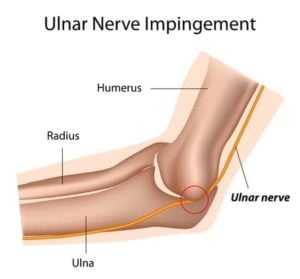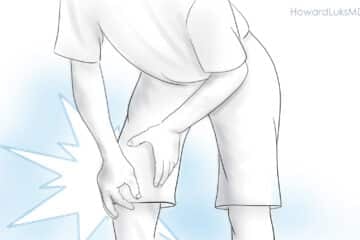
Everyone knows the term the “funny bone”. You hit the inner side of your elbow and receive a zing that goes all the way into your little finger. That sensation is caused by the ulnar nerve. Numbness or tingling in your little finger, and often the ring finger is commonly caused by compression of the ulnar nerve. Ulnar nerve compression at the elbow is also called Cubital Tunnel Syndrome.
The Ulnar nerve is located on the inner or medial side of the elbow. It runs in a groove behind a bone we call the medial epicondyle.
The ulnar nerve then travels down the forearm and ends in your little finger and half of your ring finger. The ulnar nerve can also be compressed at the wrist, but this is far less common.
Ulnar nerve compression symptoms
Symptoms of ulnar nerve compression can vary depending on how severe the compression is and how long you have had it. Early on you might have numbness or tingling in your little finger, or a portion of the hand. That numbness might occur if your lean on your elbow or if you keep your elbow bent for a long time. Bending the elbow tightens the space around the nerve. That limits the blood supply to the nerve which causes the numbness.
Over time the compression may become more severe. The ulnar nerve supplies sensation to the skin over the little finger and a portion of the hand. But it also supplies some of the muscles in the hand. If the ulnar nerve is compressed enough then you may develop weakness in your hand. You may develop weakness of your grip. You may notice that you become clumsy and start dropping things too. Some people will complain of cramping in the hand with repetitive tasks.
Treatment of ulnar nerve compression
Early on, avoiding long periods of keeping the elbow bent helps. Some people sleep with a brace or a towel taped around their elbow. This prevents the elbow from bending when they sleep and allows the ulnar nerve to recover. Remember, bending the elbow increases the pressure around the nerve.
If you develop weakness or if you have significant persistent numbness that does not improve with time or bracing then we may order an EMG test. An EMG might tell us if the ulnar nerve if severely compressed. EMG testing is not perfect and might be normal even though you still have cubital tunnel syndrome, or ulnar nerve compression.
Surgery and Recovery for Cubital Tunnel Syndrome.
Surgery for ulnar nerve compression becomes an option if your numbness or weakness persists despite bracing or rest. In treating the ulnar nerve surgically we have a few different options. We might simply perform a cubital tunnel release. This opens the roof over the groove and thus it decreases the pressure on the nerve when the elbow is bent.
Sometimes people have an “unstable” ulnar nerve, or a nerve that slides out of the groove or cubital tunnel when the elbow is bent. If your ulnar nerve is unstable, then a simple release will not work. In those cases we perform an ulnar nerve transposition. That is a bigger procedure which involves moving the ulnar nerve out of the groove and placing it in front of the medial epicondyle. Both procedures work well. Which one is best for you depends on your physical examination.















I have numb pinky & ring finger since I was diagnosed with type 2 diabetes 3years ago .Is there any chance of treatment that is appropriate ?
HI John .. It depends on what the underlying cause is. If you have “cubital tunnel syndrome” or isolated compression of the ulnar nerve then surgery is often successful. if your nerve tests show this is caused by a neuropathy due to diabetes then the surgery may not be successful.